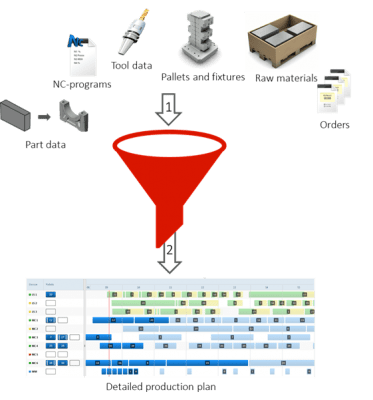Utilization rates as low as 20 percent – the unfortunate reality
Even today, it’s common for machine tool spindles in job shops to have utilization rates of around only 20 percent. What’s worse is that most of these businesses are operating under the assumption that their rates are much higher: somewhere between 60 to even 70 percent.
The harsh reality usually hits when we’re taken on a walk around their factory floor. As soon as we start to discuss the pitfalls of low utilization rates, the customer takes a step back. This is when they realize that all of these problems are what they consider “business as usual”. Then, they usually admit they didn’t think they needed automation because they don’t have high volume production. Unfortunately, this is a belief that runs deep within the metal cutting industries – it’s truly the status quo.
Amazingly however, despite having such low utilization rates, these job shops are still able to create profit and cover the salaries of their employees. The real question then becomes: how can these businesses remain profitable globally even though they’re operating so inefficiently?
The growing complexity of manufacturing can only be met by increasing the level of automation and digitalization
Companies that have taken control through automation
On the flip side you have the job shops that have taken control of their efficiency. They have achieved utilization rates of over 95 percent. What’s remarkable is that many of these companies are producing in increasingly challenging environments. This means short customer contracts, small volumes and introducing new products almost daily. Despite all this, they are still able to achieve high utilization rates.
It’s no surprise that as a consequence these businesses are real cash cows. They have the ability produce with ¼ of the machine tools, as well as higher quality, and efficiency when compared to other job shops in the manufacturing industry. Moreover, the ratio is even greater than ¼ when it comes to employee utilization. In total, these succeeding companies are 5-10 times better than the average competitor.
In the best cases, these companies have reshaped their business philosophies trying to find contracts that competitors simply don’t want. Not for a fair price at least. What enables this is the confidence in their ability to deliver, reel in great profits, and competitive edge.

Quadrupling production capacity through flexible automation solutions
We’re all aware of the current trends like industry 4.0, IIoT and so on. While there’s no denying that most goals set beneath these umbrella categories are substantial, under no circumstances do they create significant improvement if the foundations of a company’s production methods are not in sufficient condition. In fact, while solutions related to IIoT and Industry 4.0 usually seem easy to accomplish, their actual benefits are marginal and max out at around 10% growth. In other words, they’re low hanging fruit that create little value.
The truth is, only when trends like these are paired with an efficient and flexible environment can we realize their full potential. Luckily, doing so is just as easy as implementing them alone, but reels in significantly more value. In fact, at best, flexible automation solutions can increase the utilization rates of job shop machine tools up to 80 percent. In world-class customer cases, this can even go up to 95.
So, instead of focusing on the insignificant details, why wouldn’t a company choose intelligent automation and in turn immediately triple or even quadruple production capacity?
Contact us
Give us a call or send an email

Contact us
"*" indicates required fields
